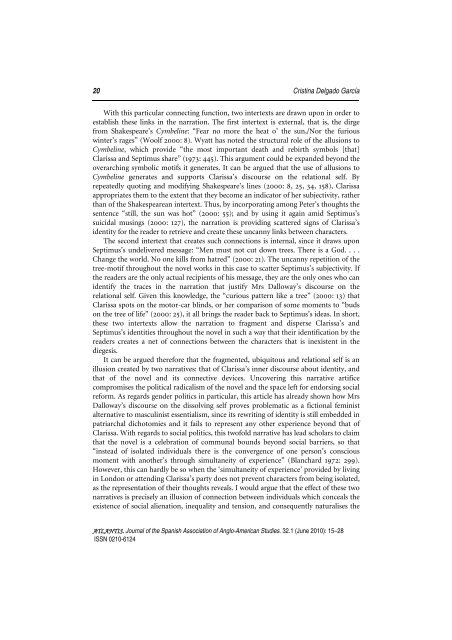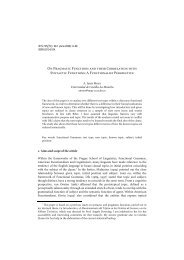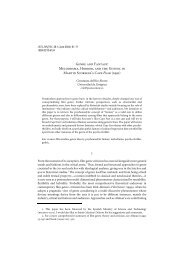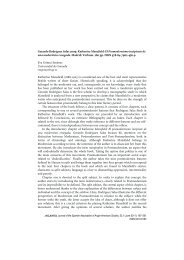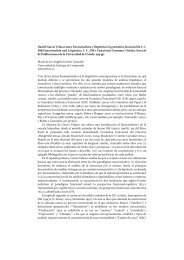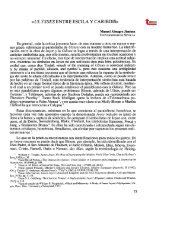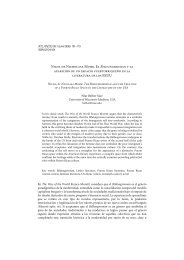Revista de la Asociación Española de Estudios Anglo - Atlantis
Revista de la Asociación Española de Estudios Anglo - Atlantis
Revista de la Asociación Española de Estudios Anglo - Atlantis
You also want an ePaper? Increase the reach of your titles
YUMPU automatically turns print PDFs into web optimized ePapers that Google loves.
20 Cristina Delgado García<br />
With this particu<strong>la</strong>r connecting function, two intertexts are drawn upon in or<strong>de</strong>r to<br />
establish these links in the narration. The first intertext is external, that is, the dirge<br />
from Shakespeare’s Cymbeline: “Fear no more the heat o’ the sun,/Nor the furious<br />
winter’s rages” (Woolf 2000: 8). Wyatt has noted the structural role of the allusions to<br />
Cymbeline, which provi<strong>de</strong> “the most important <strong>de</strong>ath and rebirth symbols [that]<br />
C<strong>la</strong>rissa and Septimus share” (1973: 445). This argument could be expan<strong>de</strong>d beyond the<br />
overarching symbolic motifs it generates. It can be argued that the use of allusions to<br />
Cymbeline generates and supports C<strong>la</strong>rissa’s discourse on the re<strong>la</strong>tional self. By<br />
repeatedly quoting and modifying Shakespeare’s lines (2000: 8, 25, 34, 158), C<strong>la</strong>rissa<br />
appropriates them to the extent that they become an indicator of her subjectivity, rather<br />
than of the Shakespearean intertext. Thus, by incorporating among Peter’s thoughts the<br />
sentence “still, the sun was hot” (2000: 55); and by using it again amid Septimus’s<br />
suicidal musings (2000: 127), the narration is providing scattered signs of C<strong>la</strong>rissa’s<br />
i<strong>de</strong>ntity for the rea<strong>de</strong>r to retrieve and create these uncanny links between characters.<br />
The second intertext that creates such connections is internal, since it draws upon<br />
Septimus’s un<strong>de</strong>livered message: “Men must not cut down trees. There is a God. . . .<br />
Change the world. No one kills from hatred” (2000: 21). The uncanny repetition of the<br />
tree-motif throughout the novel works in this case to scatter Septimus’s subjectivity. If<br />
the rea<strong>de</strong>rs are the only actual recipients of his message, they are the only ones who can<br />
i<strong>de</strong>ntify the traces in the narration that justify Mrs Dalloway’s discourse on the<br />
re<strong>la</strong>tional self. Given this knowledge, the “curious pattern like a tree” (2000: 13) that<br />
C<strong>la</strong>rissa spots on the motor-car blinds, or her comparison of some moments to “buds<br />
on the tree of life” (2000: 25), it all brings the rea<strong>de</strong>r back to Septimus’s i<strong>de</strong>as. In short,<br />
these two intertexts allow the narration to fragment and disperse C<strong>la</strong>rissa’s and<br />
Septimus’s i<strong>de</strong>ntities throughout the novel in such a way that their i<strong>de</strong>ntification by the<br />
rea<strong>de</strong>rs creates a net of connections between the characters that is inexistent in the<br />
diegesis.<br />
It can be argued therefore that the fragmented, ubiquitous and re<strong>la</strong>tional self is an<br />
illusion created by two narratives: that of C<strong>la</strong>rissa’s inner discourse about i<strong>de</strong>ntity, and<br />
that of the novel and its connective <strong>de</strong>vices. Uncovering this narrative artifice<br />
compromises the political radicalism of the novel and the space left for endorsing social<br />
reform. As regards gen<strong>de</strong>r politics in particu<strong>la</strong>r, this article has already shown how Mrs<br />
Dalloway’s discourse on the dissolving self proves problematic as a fictional feminist<br />
alternative to masculinist essentialism, since its rewriting of i<strong>de</strong>ntity is still embed<strong>de</strong>d in<br />
patriarchal dichotomies and it fails to represent any other experience beyond that of<br />
C<strong>la</strong>rissa. With regards to social politics, this twofold narrative has lead scho<strong>la</strong>rs to c<strong>la</strong>im<br />
that the novel is a celebration of communal bounds beyond social barriers, so that<br />
“instead of iso<strong>la</strong>ted individuals there is the convergence of one person’s conscious<br />
moment with another’s through simultaneity of experience” (B<strong>la</strong>nchard 1972: 299).<br />
However, this can hardly be so when the ‘simultaneity of experience’ provi<strong>de</strong>d by living<br />
in London or attending C<strong>la</strong>rissa’s party does not prevent characters from being iso<strong>la</strong>ted,<br />
as the representation of their thoughts reveals. I would argue that the effect of these two<br />
narratives is precisely an illusion of connection between individuals which conceals the<br />
existence of social alienation, inequality and tension, and consequently naturalises the<br />
ATLANTIS. Journal of the Spanish Association of <strong>Anglo</strong>-American Studies. 32.1 (June 2010): 15–28<br />
ISSN 0210-6124


